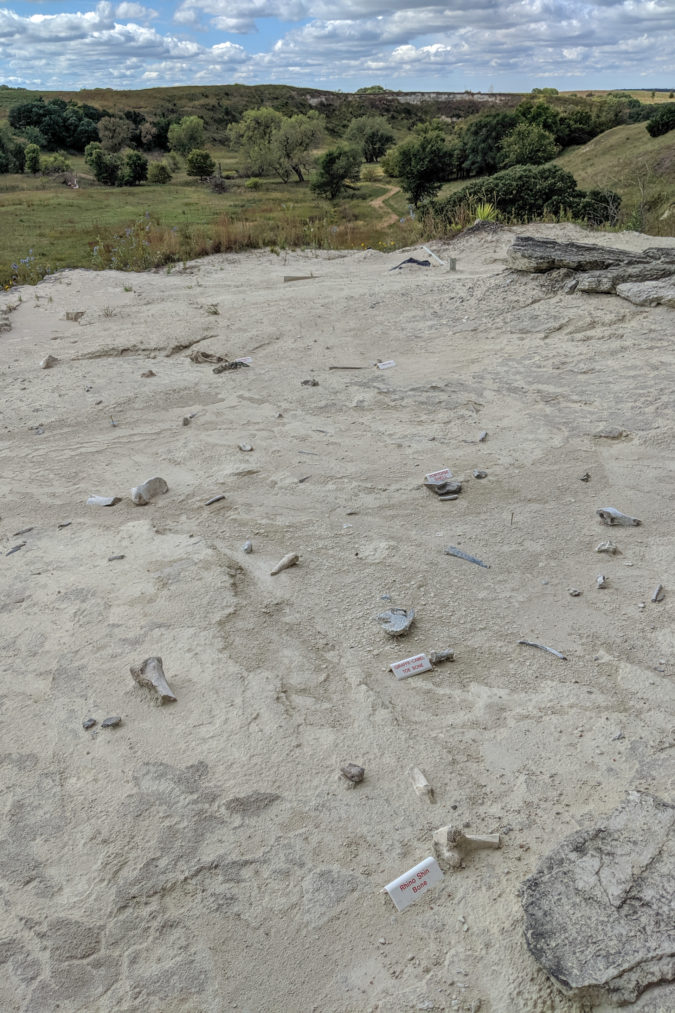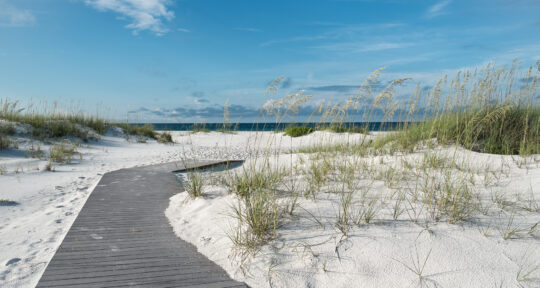I arrive at the entrance to Ashfall Fossil Beds State Historical Park just as the site supervisor is unlocking the gate. Cresting the slope to the visitor center parking lot, I’m surrounded by rolling hills, blue skies, and gently waving grass. It’s a gorgeous fall day in northeastern Nebraska, so serene that it’s hard to believe the air here was once filled with clouds of volcanic ash.
The grasslands of the Midwest aren’t what most people think of when they hear “Pompeii,” but almost 12 million years ago, a massive volcanic eruption in present-day Idaho turned an ancient waterhole in Nebraska—1,000 miles away—into a graveyard for hundreds of prehistoric animals. “It’s a little depressing, [but] it’s been a wealth of information for paleontologists,” says Kallie Moore, former site intern and now collections manager at the University of Montana Paleontology Center.
The visitor center at Ashfall Fossil Beds doubles as a museum, showcasing some of the smaller fossils found on site. I wander through, checking out the bones of extinct dogs such as Cynarctus, which used to hunt small prey around the waterhole. It’s a much smaller space than the excavation building, but the researchers have packed it with information. By the time I head out to see the dig, I’ve learned about the site’s discovery, the ancient ecosystem uncovered there, and the catastrophe that created it.
The Ashfall State Historical Park Visitor Center. | Photo: Darcy Shapiro The Hubbard Rhino Barn houses the ongoing excavation. | Photo: Darcy Shapiro Inside the Hubbard Rhino Barn. | Photo: Seth Davidovits
Behind a wall of windows, in the fossil preparation lab, visitors can watch paleontologists and volunteers painstakingly clean the ancient bones as they come out of the ground. If you want to see them at work, be sure to visit on a weekday. The lab is empty when I stop by, but partially prepared fossils—works in progress—are arranged on the benches and shelves.

Download the mobile app to plan on the go.

Share and plan trips with friends while discovering millions of places along your route.
Get the AppSkeletons in the ash
The incredible story of what happened at Ashfall Fossil Beds has been meticulously pieced together by scientists over the decades, since its discovery in 1971. A University of Nebraska paleontologist prospecting for fossils in the area glimpsed the skull of a baby Teleoceras (an extinct rhinoceros) eroding out of a layer of soft volcanic ash. That baby rhino was just the start—the rest of its herd was there, too, waiting to be discovered.


It’s that herd of rhinos that initially drew me to Ashfall Fossil Beds. The site is one of only a handful of ongoing excavations in the U.S. where you can see fossils still in the ground, and the incredible degree of preservation makes it unique. For a paleontologist, this kind of site is the dream—a chance to capture a moment in geological time that “preserves the life and death of these animals that occurred over the course of maybe only a few weeks,” Moore says.
Down the hill behind the visitor center sits the new Hubbard Rhino Barn, which was built between 2007 and 2009 to shelter the dig and fossils from the harsh Plains weather. Visitors can walk along a wooden boardwalk close to the level of the excavation or look down on the site from a second raised walkway. The interior walls of the barn opposite the boardwalk’s railing are lined with posters depicting what some of the extinct animals found here might’ve looked like.


I’d seen photos of the barn’s interior before visiting—a flat, light gray surface with the bones of dozens of prehistoric animals carefully excavated around and left in relief—but it’s even more striking in person. Visitors can observe the frozen final moments of some of the waterhole’s residents, such as the skeletons of a female rhino and her calf lying nose-to-nose. In spite of the structure’s name, the bones of many other species besides rhinos are also preserved here.
Bumpy bones and bone-crushing dogs
When the ash rained down over the course of days or weeks, it caused lung damage and eventually death. The bones of the smallest animals, turtles and birds, make up the deepest layer of the site. The mid-size animals, small horses and camels, form the middle fossil layer, and the famous rhinos reside in the uppermost layer of ash. Larger animals have larger lungs, so they were able to survive the damaging ash for longer—but it took a toll on their bones first.
“Some of the large rhinos show evidence of Marie’s disease,” Moore says. “It causes abnormal bumpy bone growth that can be seen on the fossils.” Studying these bones helps paleontologists figure out exactly what happened at the waterhole almost 12 million years ago.


The story of Ashfall Fossil Beds didn’t end when the rhinos died, though. The boardwalk around the edge of the exposed ash bed gives visitors a closer look at some of the less obvious features of the site, marked with surveyor’s flags, numbered red circles, and paper tags. One of these features, visible in the damp ash of the rhino layer, is a set of perfect footprints left behind by scavenging Borophagines (“bone-crushing dogs”), attracted by the death of the herd. Moore says that this is one of her favorite parts of the site—a reminder of the circle of life amidst the exposed skeletons.
When I visit in late September, the excavation season has already ended. The dig itself is quiet, with just a single intern left answering questions on the boardwalk. It will restart again next summer, when a new crop of aspiring paleontologists descend on the site, looking to make their own mark on the story of Ashfall Fossil Beds.
If you go
Check the Ashfall Fossil Beds website for dates and hours for the 2020 season.









